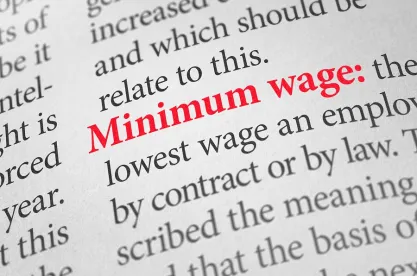Minimum wage rates for employees of the largest businesses in St. Paul will increase to $15 per hour on July 1, 2022. Other businesses in St. Paul will be required to meet the wage hike between July 1, 2023, and July 1, 2027, depending on their size.
St. Paul Minimum Wage
St. Paul has followed the lead of other major cities in adopting a minimum wage ordinance requiring employers to increase wages beyond those mandated by the State of Minnesota’s minimum wage laws. However, the ordinance enacted by St. Paul provides many employers with a longer timeline for complying than is permitted by the ordinance adopted in 2017 by St. Paul’s “twin city,” Minneapolis.
The 2018 ordinance, which the St. Paul City Council approved on November 14, 2018, by a 7–0 vote, requires the city and large businesses to pay their employees at least $15 per hour beginning July 1, 2022. Smaller employers will be required to begin paying their employees $15 per hour by July 1, 2027. The St. Paul ordinance’s compliance timeline, however, contrasts with that of the Minneapolis ordinance, which similarly required large businesses to begin paying their employees $15 per hour by July 1, 2022, but required small businesses to meet the wage increase by July 1, 2024.
Like the 2017 Minneapolis ordinance, the 2018 ordinance adopted by St. Paul will define “large” and “small” employers differently than the state law does. The St. Paul ordinance creates four separate categories of employers for the purpose of determining when and how wage increases will affect them. The first category of employers includes the City of St. Paul and “macro businesses,” which the ordinance defines as businesses with more than 10,000 employees. The second category of employers covers “large businesses,” meaning those with more than 100 employees. The third category of employers, “small businesses,” includes those businesses that employ between 6 and 100 employees. The fourth and final category of employers, “micro businesses,” are those with 5 or fewer employees.
The 2018 ordinance establishes, similar to the Minneapolis ordinance, a series of mandatory wage jumps that transition employers to the full $15 per hour by the deadline established above.
- The ordinance requires the City of St. Paul and macro business to increase employee wages to $12.50 per hour by January 1, 2020, and then to the full $15 per hour by July 1, 2022.
- The ordinance requires large businesses to increase wages to $11.50 per hour by July 1, 2020, and then make the final hike to $15 per hour by July 1, 2023.
- The ordinance requires small businesses to increase wages to $10 per hour by July 1, 2020, and increase to $15 per hour by July 1, 2025.
- The ordinance requires micro businesses to increase pay to $9.25 per hour by July 1, 2020, and to $15 per hour by July 1, 2027.
The 2018 ordinance also features several notable exemptions. First, workers between 14 and 17 years old must be paid a minimum of 85 percent of the minimum wage of employees in the “small business” employer category for their first 90 days on the job, and they must then be paid the applicable minimum wage, depending on which category of employer they are employed by. Additionally, the ordinance exempts employees who are covered by collective bargaining agreements.
Minnesota Statewide Minimum Wage Increase
Minimum wage rates for the majority of employees in Minnesota increased on January 1, 2018, as part of the automatic increases authorized by a 2014 amendment to the Minnesota Fair Labor Standards Act. Most employees received a wage increase of $.15 per hour. Minimum wages for employees of “large employers,” which state law defines as employers with annual gross revenues of $500,000 or more, rose from $9.50 per hour to $9.65 per hour, while the minimum wage of employees of “small employers,” those with annual gross revenues of less than $500,000, rose from $7.75 to $7.87 per hour. These increases were calculated based on the rate of inflation at the beginning of 2018, and they will continue to be adjusted annually at the beginning of each year.
In August 2018, the Minnesota Department of Labor and Industry announced wages will increase on January 1, 2019, for employees statewide. The minimum wage for employees of large employers will grow to $9.86 per hour, and the rate for employees of small employers will rise to $8.04 per hour.
Key Takeaways
St. Paul has joined a series of other cities in establishing a local minimum wage for those businesses operating in the city. Minnesota employers may recall that Governor Mark Dayton ultimately vetoed and the Republican-controlled legislature subsequently abandoned a bill to preempt all municipal or other local laws dealing with the minimum wage, safe and sick time, and other types of employer-employee regulations, which the Minnesota legislature had passed in 2017. As a result, it is unlikely, at least for the foreseeable future, that legal challenges or impediments will block or minimize the effects of the new St. Paul ordinance.
Under the ordinance, employees are covered by the wage increases for all the time worked within the geographic boundaries of the City of St. Paul. This includes employees who typically work outside the city if they perform at least two hours of work within city limits over the course of one week. Thus, employers with employees working in St. Paul may have to pay higher minimum wages than those required for employees working in other cities in the state. Employers should also note the minimum wage will be indexed to inflation in the year following the applicable phase-in deadline, and in each year thereafter. Many employers, particularly those with employees covered by collective bargaining agreements, may find the new law of little consequence immediately, but the annual increases that will begin for some businesses as early as January 1, 2020, may be difficult for some employers to absorb.
Employers with employees working in other cities in the state should also monitor ordinances being considered by those cities’ local councils. A growing number of Minnesota cities have passed or are considering ordinances similar to those enacted by St. Paul and Minneapolis. Duluth, for example, passed a safe and sick time ordinance in May 2018. Other cities in the state have similar measures under consideration that, if passed, are likely to create a patchwork of local requirements that employers will need to navigate.





 />i
/>i

